Do you run an online business?
Do you want to keep earning more from your online business?
That last question was a little ridiculous because of course, you do. And, answering “yes” is exactly why you need to learn more about sales funnels. A sales funnel is a core piece of your digital marketing strategy. And once you have it in place and generating sales for you, it’s how you can get back to serving your customers.
What is a sales funnel?
Sales funnels are a hot topic right now in the digital marketing world, but they’re essentially a marketing strategy.
A sales funnel is what you use to guide prospective customers down the path to becoming paying ones.
It’s finding the right audience, putting offers in front of them, showing them exactly where to go to learn more, catching the ones who are still “thinking about it,” and then making a sale.
The funnel analogy is used because it’s a helpful way to illustrate that you are going to start with a large number of prospective customers, and as they go farther into the buying process, you’ll inevitably lose some of them, leaving a smaller pool of paying customers at the end.
Why is a sales funnel important for my business?
Sales funnels work for selling both products and services, which means if you are trying to sell either, then your business will benefit from a sales funnel.
In order to stay in business, you need to find paying customers. How do you do that? With a sales funnel!
Here’s the other really cool thing about a sales funnel, and this was alluded to in the intro – a sales funnel gives you more time to serve the customers you already have. Because a sales funnel is something you can build online (more on that in a minute), implement, and then as long as it’s working, you can just let it do its work.
The sales funnel you build is growing your customer base for you, and you can focus on other stuff, like creating content, interacting with your customers, coming up with new products or services, whatever! It’s not an entirely passive strategy, though, because you’re going to need to check in on it and make adjustments as needed.
And just to be clear, here are some business that can benefit from a sales funnel:
- A blogger who is about to launch their first course
- A freelance photographer who wants to sell an eBook
- A digital marketer who wants to grow their business
Remember, if you have something to sell, you can do it with a sales funnel. One important thing to note, though, you can’t fix a bad offer with a sales funnel. If your product isn’t on point, if your services are priced too high, whatever, you’ll need to fix that. The good news is that a sales funnel can help you see what your issue is and maybe even how to fix it.
Breaking down the sales funnel: how it works
You’ve got the basic gist of what a sales funnel is and why you need it for your business, but now it’s time for the nitty gritty details that really answer the question, “what is a sales funnel?”
When a prospective customer comes to your website (through a Google search or social media link), they’ll spend a little time on your site, maybe clicking around a bit. At this point, they sit at the very top of the sales funnel, aware of your business, but that’s it.
If they use your email opt-in form to give you their email address, that prospective customer is now expressing some interest and starting to engage with your business. They are now in the middle of your funnel and are now considered a lead.
You can now send your lead an email that gets them excited about a product or service. They might not bite on the first email, so that’s why you can send them another email in a few days, week, etc. This will depend on what you’re selling and how complex you want your funnel to be. Then, when your lead purchases something, you’ve converted them!
That’s a really basic example because when you build your first sales funnel, you want to keep things as simple as possible. There are some awesome next level steps, but this is where you start – with a website, an email list and a place for them to join in, and some emails that tell them about your offers.
Three Stages of a Sales Funnel
As you probably gathered from that last section, a sales funnel can be separated into three different stages. You will sometimes see sales funnels broken down into four stages, but three is what we like and teach our students in the Facebook Side Hustle Course.

Stage 1 – Awareness
This is the first time a prospective customer notices you’re there, and for an online business, it’s all about visibility. You want your customer to see your business or find your website. You want them to read your articles so that they can find whatever products, services, or courses you want them to purchase down the line. And, it’s important to link to the pages for those when it’s appropriate.
Getting customers via Google searches is the type of organic traffic online businesses hope for, but for most, especially growing ones, waiting for a customer to stumble across your website in a Google search isn’t enough.
You will need to create more opportunities for customers to find you. That could be via Facebook ads and social media posts. At the same time, you should be working on SEO (search engine optimization) to increase your chances to be seen in Google searches.
Stage 2 – Engagement
Once you have their attention, you’ll need to keep it by giving them a reason to stay on your website long enough to sign-up for your email list. That means you’ll need high-quality content. If you’re a blogger, then you already know the importance of “epic” content, but every business can benefit from a high-quality copy that tells them more about what you have to offer.
The average customer doesn’t give up their email address without a good reason, which is why lead magnets are an excellent trade for an email address. Depending on your business, this could be a free PDF printable, an eBook, mini-course, etc.
If you don’t have a lead magnet yet, at the very least, create an email opt-in form that tells prospective customers something as simple as “Join my email list to stay updated on my latest offers and to hear more from me.”
You’ll hear digital marketers say that your email list is your lifeblood, and that’s 100% true. Your email list is how you tell leads about any new products and services you have to offer. It’s where you’ll explain more about how you can help address their needs, which is super important for the final stage.
Read more at Why You Should Start an Email List in 2019
Stage 3 – Conversion
When a lead is reading your emails and growing their interest in your products or services, they’re reaching the bottom of your sales funnel. You should be dripping out email content on a regular basis, but don’t do it too often or you’ll run the risk of losing them – you are slowly building interest with emails.
This is also when the relationship gets serious. It’s when you present the best possible version of yourself. You’re giving them more and more, and this is when more complex funnels can trigger a new email sequence that depends on how people interact with the emails you have already sent.
When they click “buy,” that’s the action you’ve been leading them towards. It’s the bottom of the funnel where you convert them into a customer.
Creating content for your sales funnel
As you’ve seen, guiding customers through your funnel will take creating different forms of digital content to increase your visibility, to help you interact with potential customers, and to lead them to their first sale with you. That’s right, first! The goal is to keep them coming back for more.
Whether you think of yourself as a content creator or not, online business owners are, in one way or another, content creators. And, here’s how different types of content relate to your sales funnel:
- Blog posts. You don’t need to be a blogger to blog about your business. If you’re a freelance editor, for example, you can write a semi-weekly blog post that explains different writing issues and how to fix them. That shows prospective customers what you can do and how you can help. If you’re optimizing your site for SEO, blog posts increase your ability to be found in Google searches.
- Social media posts. Social media gives prospective customers one more place to find your business. You can create a page for your business, buy FB ads, and use social media posts to get customers to your website.
- Lead magnets. This was already mentioned, but lead magnets are often what you trade for an email address. And even though your lead magnet is free, it should be a high-quality offer. Your lead magnet should answer an issue or problem your customer has, and this will show them that you’re worthy of their time and money when you present them with an offer down the line.
- Videos. Posting videos to YouTube give online business owners the unique opportunity to interact more personally with customers through YouTube’s fully-functioning search engine. It’s incredibly important to give them a call-to-action (CTA) at the end of each video, telling them how to sign up for your email list, or where to buy a product.
- Emails. Your content creation energy shouldn’t stop at the last stage of the funnel because emails are often the most important content you create for your funnel. It’s a place to be real with your customers, sharing more than you normally would. You should also be sending emails more than just during campaign periods. Emails remind customers that you’re out there.
Here’s an example of one our sales funnels at Laptop Empires
Your first funnel, or any funnel you create, may look a little different than our funnel for the Facebook Ads for Bloggers Course, but that’s because all businesses are different. The purpose of this example is to show you what awareness, engagement, and conversion actually looks like in practice.
Step 1: Types of content for your funnel (creating awareness)
Blogs posts are a great way to build awareness for the products and services you’re selling. You can give an in-depth description of your products, talk about results (when you have them to share), and create a sense of urgency.
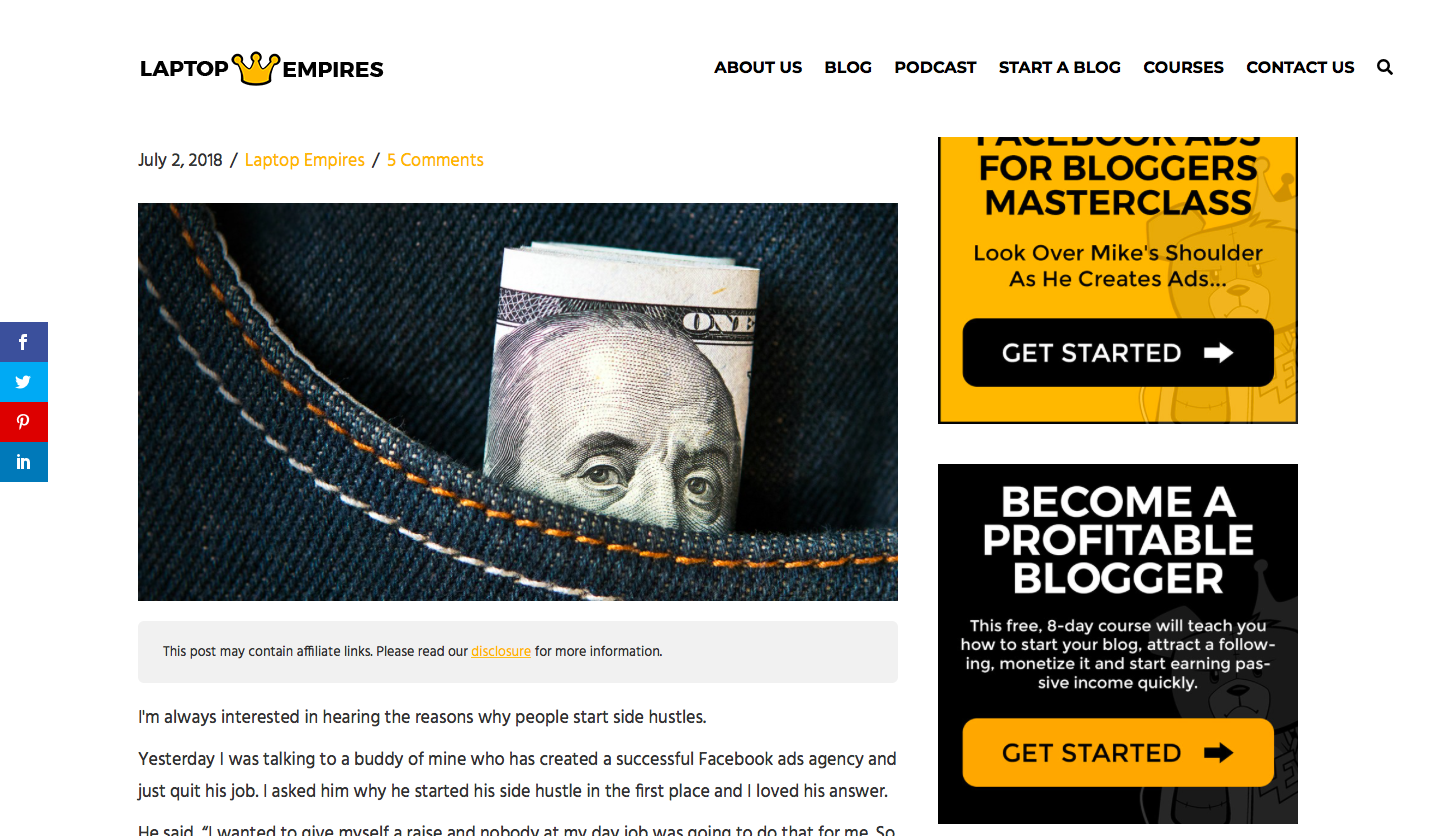
But, because Laptop Empires is more than just a blog, we also have a number of podcast episodes that present our course to listeners:
- Episode 27: The Most Profitable Side Hustle of 2018
- Episode 5: Our Favorite Side Hustles
- Episode 17: Four Reasons That Side Hustle Fail
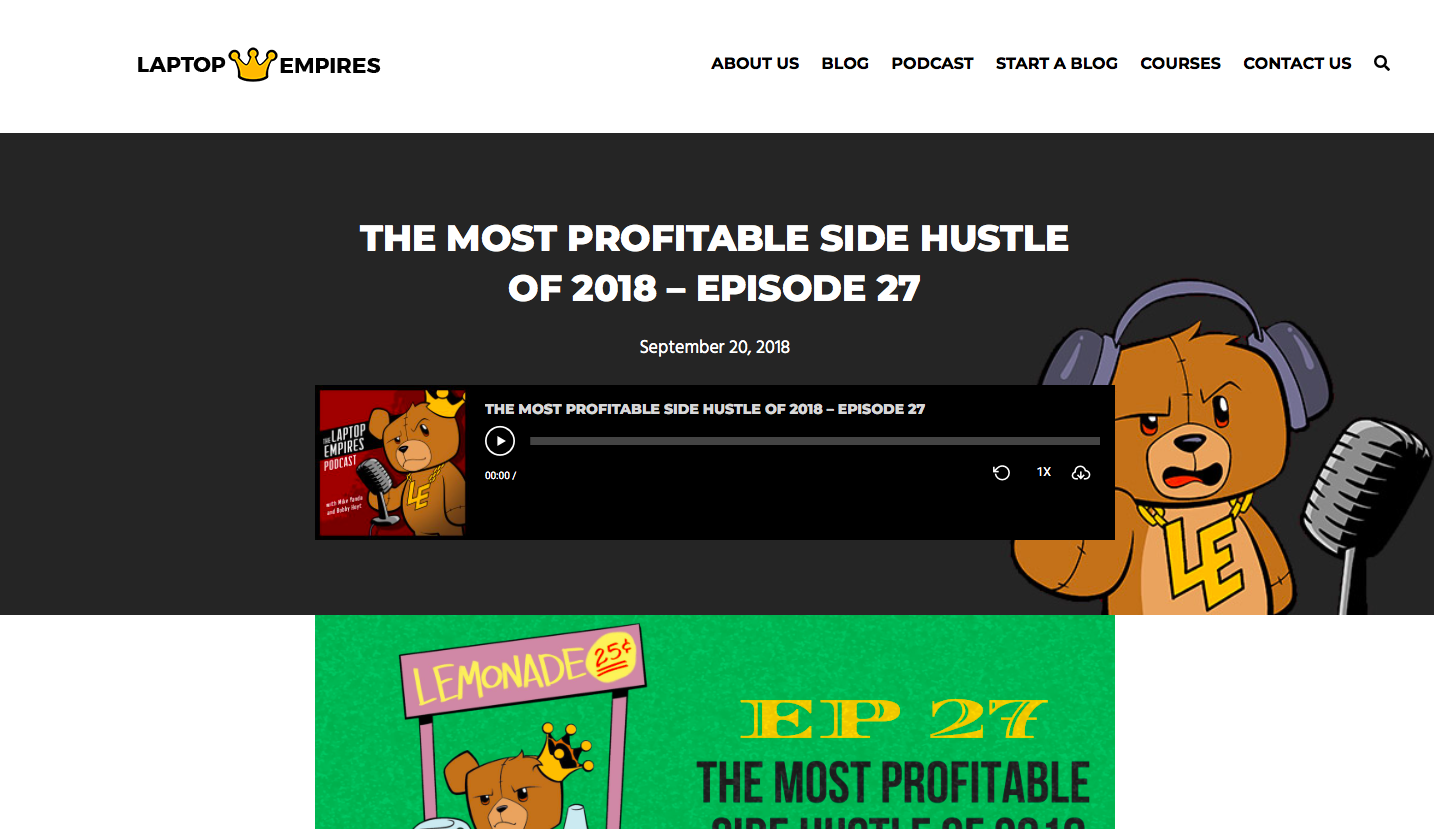
Those podcasts don’t solely talk about our course, and the same goes for the articles on Millennial Money Man that talk about blogging, but they all present opportunities for listeners and readers to learn more. There are mentions and links to course when applicable – this is awareness.
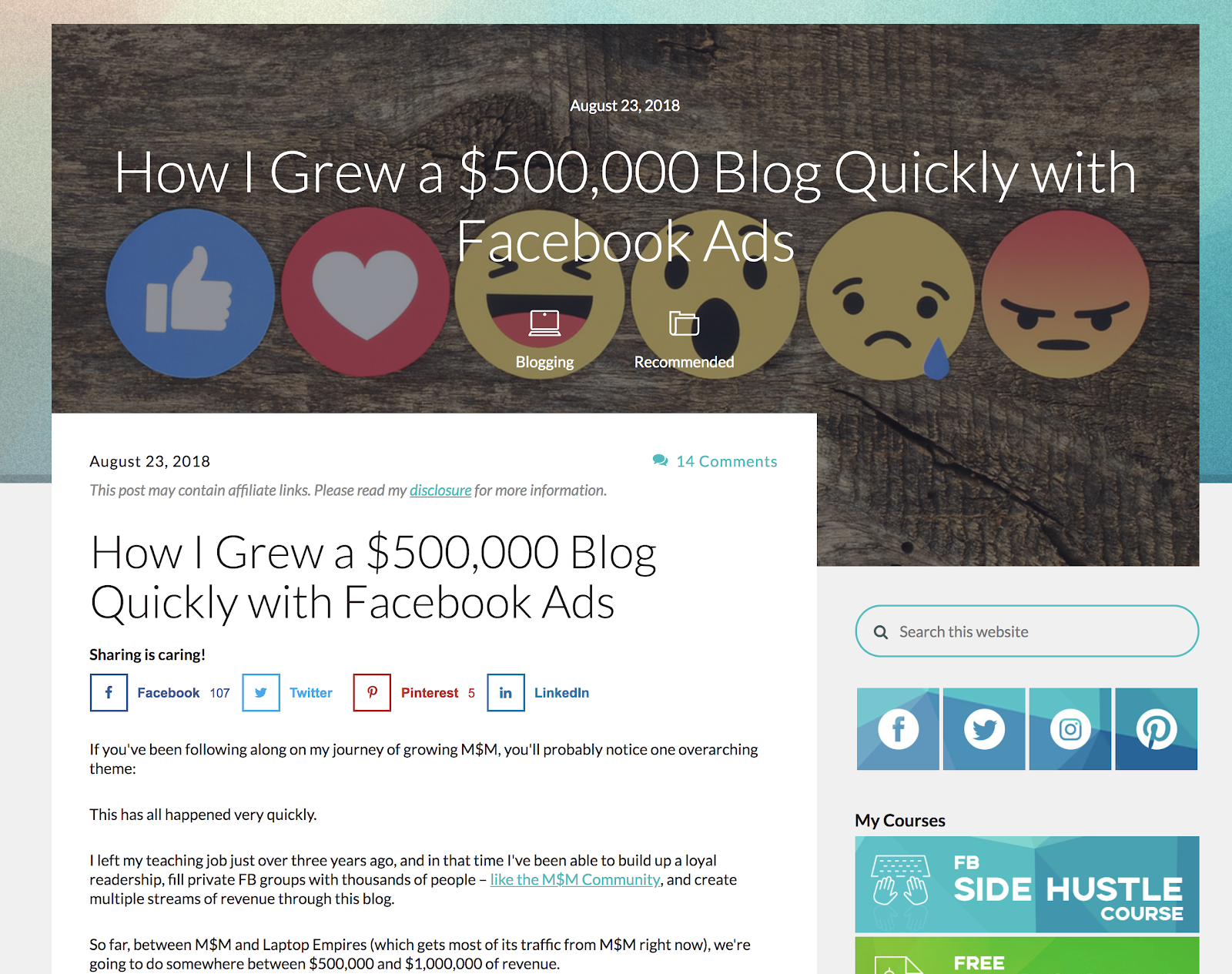
Step 2: Engage your readers
Reading about what you’re selling isn’t quite enough for most potential customers – you need to lead them further into your funnel, and that means getting their email address.
Emails offer a significantly higher conversion rate than if someone just read an article on your blog alone. And, to get that email address, you need to offer them something in return.
This is where lead magnets come in.
Here’s a lead magnet we use to grow our email list for Laptop Empires while also presenting our FB Ads for Bloggers course:
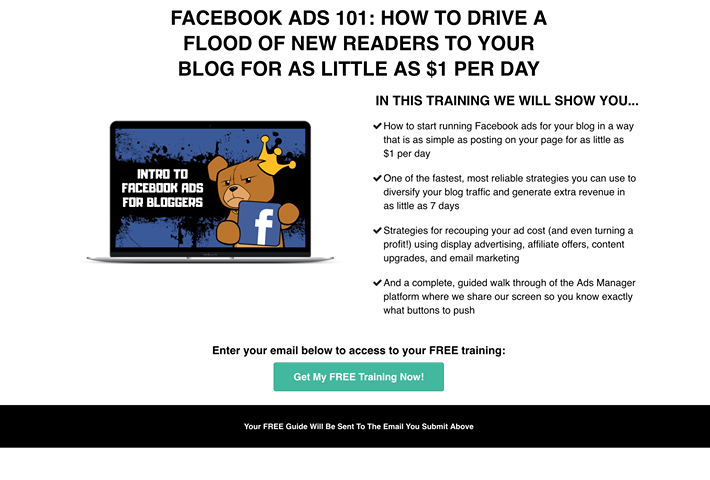
At this point, readers have heard how the Facebook Ads Course can help them, and with this lead magnet, we’re giving them a small sample of what our course offers. More importantly, by signing up for that free training, we’ve gotten their email address.
Now we can put them into our email automation and send them emails on a daily/weekly basis. At this point in the funnel, you are dripping out content that grows their interest even more.
Pro tip: ClickFunnels provides everything you need for email automation, landing pages, and sales pages to optimize your funnel. Read more at our ClickFunnels Review: Pricing and Features.
Step 3: Conversion
Before you can convert anyone, you need to have a landing page for your sales funnel. For many sales funnels, this is the final push before you bring them to your cart to checkout.
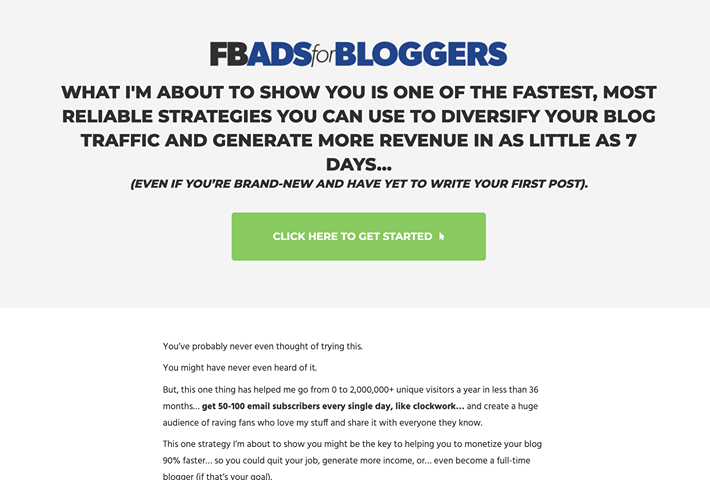
Our landing page for the Facebook Side Hustle Course gives our readers even more information on the course, it tells a story, and leads potential customers to the end of the funnel. For our sales page, we decided to hire an expert copywriter, our good friend Chris Orzechowski, to help us get our message across to potential customers.
But, you don’t need to have a copywriter to create a high-quality landing or sales page, and we have an entire episode to help you with yours – Secret to Crafting a Killer Sales Page.
Once a reader goes over your sales page, you’ll need the actual checkout page. Here’s an example of ours:
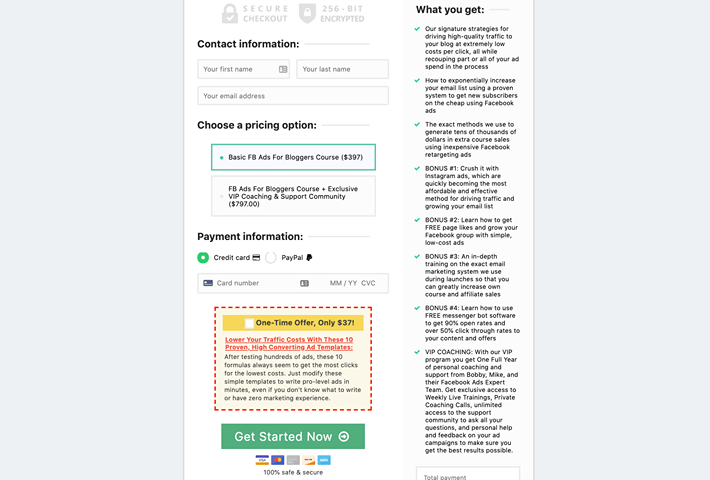
Customer retention: an important next step
After you’ve converted a customer, make sure you send an email thanking them for their business. You can also check in to see how they’re doing. It’s reminding customers that you care about more than just their dollars. You genuinely want to know how they’re doing, which in turn, tells you how you’re doing.
ClickFunnels creates thank-you emails for you, which is another reason why we like using them so much.
Sales funnels: the final word
What you’ve just read is a broad overview of the burning question that many online business owners have: What is a sales funnel? This information is the foundation for creating your first sales funnel, which you can tweak and optimize once you’ve learned more about your customers and how your funnel performs.
There’s no one right way to do a sales funnel either, but if you focus on the three stages (Awareness, Engagement, Action), then you’ll have a good grasp on what’s going to work for your customers and your business.
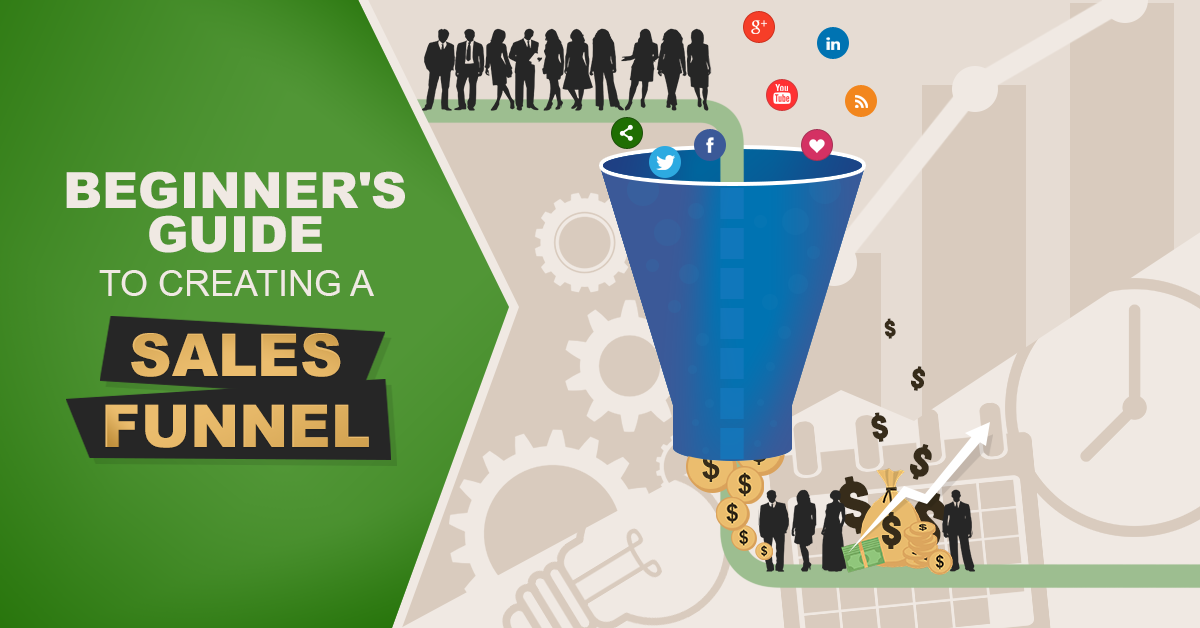

Leave a Reply